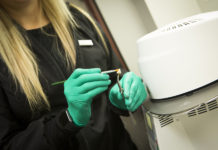The Diode Laser creates an intense beam of light energy that moves through a fiber optic cord. When it enters the targeted tissue, the energy is converted into heat as a result of the tissue’s pigmentation. A photo-thermal reaction occurs that results in a much localized thermal effect causing vaporization (or ablation) of this targeted tissue, with “very little collateral tissue damage.”
The primary use of a soft-tissue laser is the modification or removal of intra-oral soft tissue. The photo-thermal effects of the laser’s energy allow the operator to modify tissues and control hemostasis at the same time by coagulation. The post-operative response of the laser care will usually produce a cleaner and healthier surgical site with less discomfort when compared to alternative methods of surgery. Soft tissue lasers enable minor surgical procedures and decontaminate the area at the same time. There is less chance of infection, and some soft tissue procedures around the gingiva can be completed without anesthesia.
The laser also promotes healing for infected and irritated tissues. Since there is a favorable response to laser treatment, the resultant healing is less complicated and often shorter when compared to traditional techniques. In many cases, the laser can also be used to treat deep gingival pockets that harbor bacteria and cause gum disease. An additional benefit of dental diode laser technology is its ability to reduce the pain and longevity of cold sores and fever blisters.











